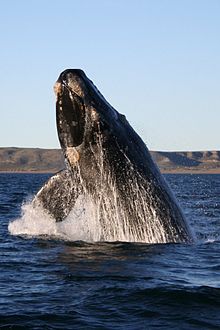
Back Walvis Afrikaans Hwæl ANG حوت Arabic ܩܐܛܐ (ܚܝܘܬܐ) ARC حوت ARZ Paus BAN Balyena BCL Кіты Byelorussian Кіты BE-X-OLD Lodan BEW
| Whale An informal group within the infraorder Cetacea | |
|---|---|

| |
| Southern right whale | |
| Scientific classification | |
| Domain: | Eukaryota |
| Kingdom: | Animalia |
| Phylum: | Chordata |
| Class: | Mammalia |
| Order: | Artiodactyla |
| Clade: | Cetaceamorpha |
| Infraorder: | Cetacea |
| Groups included | |
| |
| Cladistically included but traditionally excluded taxa | |
| |
Whales are a widely distributed and diverse group of fully aquatic placental marine mammals. As an informal and colloquial grouping, they correspond to large members of the infraorder Cetacea, i.e. all cetaceans apart from dolphins and porpoises. Dolphins and porpoises may be considered whales from a formal, cladistic perspective. Whales, dolphins and porpoises belong to the order Cetartiodactyla, which consists of even-toed ungulates. Their closest non-cetacean living relatives are the hippopotamuses, from which they and other cetaceans diverged about 54 million years ago. The two parvorders of whales, baleen whales (Mysticeti) and toothed whales (Odontoceti), are thought to have had their last common ancestor around 34 million years ago. Mysticetes include four extant (living) families: Balaenopteridae (the rorquals), Balaenidae (right whales), Cetotheriidae (the pygmy right whale), and Eschrichtiidae (the grey whale). Odontocetes include the Monodontidae (belugas and narwhals), Physeteridae (the sperm whale), Kogiidae (the dwarf and pygmy sperm whale), and Ziphiidae (the beaked whales), as well as the six families of dolphins and porpoises which are not considered whales in the informal sense.
Whales are fully aquatic, open-ocean animals: they can feed, mate, give birth, suckle and raise their young at sea. Whales range in size from the 2.6 metres (8.5 ft) and 135 kilograms (298 lb) dwarf sperm whale to the 29.9 metres (98 ft) and 190 tonnes (210 short tons) blue whale, which is the largest known animal that has ever lived. The sperm whale is the largest toothed predator on Earth. Several whale species exhibit sexual dimorphism, in that the females are larger than males.
Baleen whales have no teeth; instead, they have plates of baleen, fringe-like structures that enable them to expel the huge mouthfuls of water they take in while retaining the krill and plankton they feed on. Because their heads are enormous—making up as much as 40% of their total body mass—and they have throat pleats that enable them to expand their mouths, they are able to take huge quantities of water into their mouth at a time. Baleen whales also have a well-developed sense of smell.
Toothed whales, in contrast, have conical teeth adapted to catching fish or squid. They also have such keen hearing—whether above or below the surface of the water—that some can survive even if they are blind. Some species, such as sperm whales, are particularly well adapted for diving to great depths to catch squid and other favoured prey.
Whales evolved from land-living mammals, and must regularly surface to breathe air, although they can remain underwater for long periods of time. Some species, such as the sperm whale, can stay underwater for up to 90 minutes.[2] They have blowholes (modified nostrils) located on top of their heads, through which air is taken in and expelled. They are warm-blooded, and have a layer of fat, or blubber, under the skin. With streamlined fusiform bodies and two limbs that are modified into flippers, whales can travel at speeds of up to 20 knots, though they are not as flexible or agile as seals. Whales produce a great variety of vocalizations, notably the extended songs of the humpback whale. Although whales are widespread, most species prefer the colder waters of the Northern and Southern Hemispheres and migrate to the equator to give birth. Species such as humpbacks and blue whales are capable of travelling thousands of miles without feeding. Males typically mate with multiple females every year, but females only mate every two to three years. Calves are typically born in the spring and summer; females bear all the responsibility for raising them. Mothers in some species fast and nurse their young for one to two years.
Once relentlessly hunted for their products, whales are now protected by international law. The North Atlantic right whales nearly became extinct in the twentieth century, with a population low of 450, and the North Pacific grey whale population is ranked Critically Endangered by the IUCN. Besides the threat from whalers, they also face threats from bycatch and marine pollution. The meat, blubber and baleen of whales have traditionally been used by indigenous peoples of the Arctic. Whales have been depicted in various cultures worldwide, notably by the Inuit and the coastal peoples of Vietnam and Ghana, who sometimes hold whale funerals. Whales occasionally feature in literature and film. A famous example is the great white whale in Herman Melville's novel Moby-Dick. Small whales, such as belugas, are sometimes kept in captivity and trained to perform tricks, but breeding success has been poor and the animals often die within a few months of capture. Whale watching has become a form of tourism around the world.
- ^ "When whales walked on four legs". www.nhm.ac.uk. Retrieved 12 March 2022.
- ^ Gray 2013.